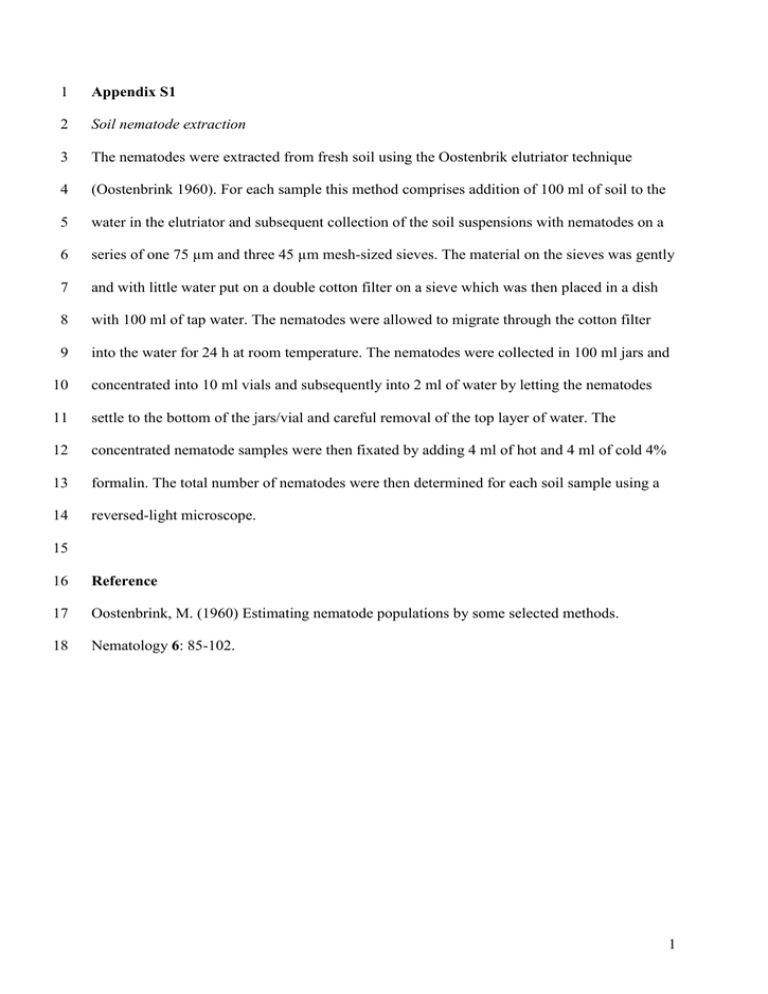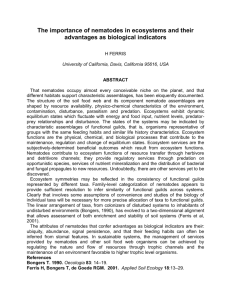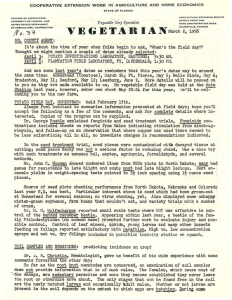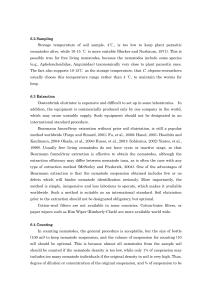ECE31337-sup-0001-supinfo
advertisement

1 Appendix S1 2 Soil nematode extraction 3 The nematodes were extracted from fresh soil using the Oostenbrik elutriator technique 4 (Oostenbrink 1960). For each sample this method comprises addition of 100 ml of soil to the 5 water in the elutriator and subsequent collection of the soil suspensions with nematodes on a 6 series of one 75 µm and three 45 µm mesh-sized sieves. The material on the sieves was gently 7 and with little water put on a double cotton filter on a sieve which was then placed in a dish 8 with 100 ml of tap water. The nematodes were allowed to migrate through the cotton filter 9 into the water for 24 h at room temperature. The nematodes were collected in 100 ml jars and 10 concentrated into 10 ml vials and subsequently into 2 ml of water by letting the nematodes 11 settle to the bottom of the jars/vial and careful removal of the top layer of water. The 12 concentrated nematode samples were then fixated by adding 4 ml of hot and 4 ml of cold 4% 13 formalin. The total number of nematodes were then determined for each soil sample using a 14 reversed-light microscope. 15 16 Reference 17 Oostenbrink, M. (1960) Estimating nematode populations by some selected methods. 18 Nematology 6: 85-102. 1 19 Table S1. Number of nematodes per 100 g dry soil (mean ± SE between plots), feeding type 20 and taxa composition according to Yeates et al. (1993), Bongers (1994) and Andrássy (2005). 21 The soil cores (15 cm depth and 5 cm diameter) were collected from the inner 2.5 × 2.5 m 22 square of each experimental plot (3 × 3 m) in a regular 0.5 × 0.5 m grid. Order Root-feeding Diphtherophorida Dorylaimida Tylenchida Tylenchida Tylenchida Tylenchida Tylenchida Tylenchida Tylenchida Tylenchina Tylenchida Family Genus Abundance ± SE Trichodoridae Nordiidae Anguinidae Hoplolaimidae Meloidogynidae Paratylenchidae Pratylenchidae Tylenchidae Tylenchidae Telotylenchidaea Tylenchidae Trichodorus Pungentus Ditylenchus Helicotylenchus Meloidogyne Paratylenchus Pratylenchus Filenchus Malenchus Tylenchorhynchus Other Tylenchidae 7.0 ± 1.9 23.4 ± 3.2 7.5 ± 1.4 2.7 ± 1.6 41.4 ± 6.8 106.9 ± 21.7 35.0 ± 8.8 15.3 ± 2.7 0.2 ± 0.2 17.5 ± 4.8 13.8 ± 3.4 Bacterivorous Alaimida Alaimida Araeolaimida Araeolaimida Araeolaimida Araeolaimida Araeolaimida Araeolaimida Araeolaimida Enoplida Monhysterida Monhysterida Rhabditida Rhabditida Rhabditida Rhabditida Rhabditida Rhabditida Rhabditida Rhabditida Rhabditida Rhabditida Rhabditida Alaimidae Amphidelidaee Bastianiidae Cylindrolaimidae Metateratocephalidaed Plectidae Plectidae Plectidae Plectidae Prismatolaimidae Monhysteridae Monhysteridae Cephalobidae Cephalobidae Cephalobidae Bunonematidae Cephalobidae Cephalobidae Cephalobidaeb Mesorhabditidaec Panagrolaimidae Rhabditidae Teratocephalidae Alaimus Paramphidelus Bastiania Cylindrolaimus Metateratocephalus Anaplectus Plectus Tylocephalus Wilsonema Prismatolaimus Eumonhystera Monhystera Acrobeles Acrobeloides Acrolobus Bunonema Cervidellus Chiloplacus Eucephalobus Mesorhabditis Panagrolaimus Teratocephalus 13.9 0.7 2.1 5.0 0.3 63.7 187.3 52.8 28.8 56.0 5.4 0.9 444.1 332.5 2.4 3.4 19.9 6.1 129.1 1.9 94.5 162.4 7.0 Fungivorous Aphelenchida Aphelenchida Aphelenchidae Aphelenchoididae Aphelenchus Aphelenchoides 385.4 ± 30.1 259.7 ± 29.1 ± 2.1 ± 0.5 ± 1.2 ± 1.7 ± 0.3 ± 10.0 ± 22.9 ± 12.2 ± 3.4 ± 6.6 ± 1.5 ± 0.6 ± 27.7 ± 24.8 ± 1.0 ± 1.5 ± 3.9 ± 1.7 ± 22.2 ± 1.1 ± 18.5 ± 35.5 ± 3.4 2 Diphtherophorida Dorylaimida Diphtherophoridae Tylencholaimidaef Diphterophora Tylencholaimus Omnivorous Dorylaimida Dorylaimida Dorylaimida Dorylaimida Dorylaimida Dorylaimida Dorylaimida Dorylaimidaei Qudsianematidae Qudsianematidae Qudsianematidaeh Qudsianematidae Qudsianematidae Qudsianematidae Mesodorylaimus Crassolabiumj Dorydorella Ecumenicus Epidorylaimus Eudorylaimus Microdorylaimus 24.4 ± 3.2 6.0 ± 1.6 13.5 118.2 11.0 22.9 1.4 2.5 16.3 ± 3.8 ± 9.8 ± 2.5 ± 4.2 ± 0.8 ± 0.9 ± 3.7 Carnivorous Dorylaimida Aporcelaimidae Aporcelaimus 59.0 ± 4.6 Dorylaimida Mydonomidaeg Dorylaimoides 17.9 ± 4.8 Dorylaimida Nygolaimidae Nygolaimus 0.3 ± 0.3 Dorylaimida Nygolaimidae Sectonema 0.3 ± 0.3 k Dorylaimida Paraxonchiidae Paraxonchium 5.2 ± 1.6 Mononchida Mononchidae 141.9 ± 11.9 Rhabditida Neodiplogastridae 8.2 ± 2.1 a b According to Bongers (1994): Dolichodoridae; Diplopeltidae; cRhabditidae; d Teratocephalidae; eAlaimidae; f,gLeptonchidae; h,iThornenematidae; jThonus; k Aporcelaimidae. 23 24 References 25 Andrássy, I. (2005) Free-living nematodes of Hungary: Nematoda errantia. Budapest: 26 Hungarian Natural History Museum: Systematic Zoology Research Group of the 27 Hungarian Academy of Sciences, Budapest, Hungary. 28 Bongers, T. (1994) De Nematoden van Nederland. Pirola, Schoorl, Utrecht, The Netherlands. 29 Yeates, G.W., Bongers, T., de Goede, R.G.M., Freckman, D.W. & Georgieva, S.S. (1993) 30 Feeding-habits in soil nematode families and genera - an outline for soil ecologists. 31 Journal of Nematology, 25, 315-331. 3 32 Appendix S2 33 Structural equation modelling procedure 34 All variables used in the SEM were observed variables. The reciprocal effects of soil insects 35 or root-feeding nematodes on plant root biomass and higher trophic level organisms on their 36 prey were excluded from the initial model because plant diversity was experimentally 37 manipulated in our study. 38 39 Table S2. Standardized coefficients of the reciprocal pathways between the fixed factors in 40 SEM models. Plant diversity Legumes Forbs Grasses Plant diversity 1 -0.03 0.20 0.15 Legumes -0.03 1 -0.52 -0.20 Forbs 0.20 -0.52 1 -0.56 Grasses 0.15 -0.20 -0.56 1 41 4 Appendix S3 -1 Root biomass (g 100 g soil) 0.16 0.25 (A) (B) b 0.20 0.12 b 0.15 ab 0.08 ab 0.10 0.04 re p A. T. co rn i cu la tu s 0.00 L. Soil mositure content (%) a 0.05 0.00 18 ab ab ab en m s ille fo liu H m .r ad ic at L. a vu l ga P. re la nc eo la ta T. vu lg ar e F. ru br a 42 Monoculture identity (C) 16 14 12 10 8 6 4 2 0 0 43 1 2 4 9 Plant diversity 44 45 Fig. S1. Community root biomass in the plots with different plant diversity (A) and in 46 different monocultures (B); and soil moisture content in the plots with different plant diversity 47 (C). Means ± SE are shown. Different letters denote significant differences between 48 monocultures (P < 0.05) based on a Tukey HSD test. 5











